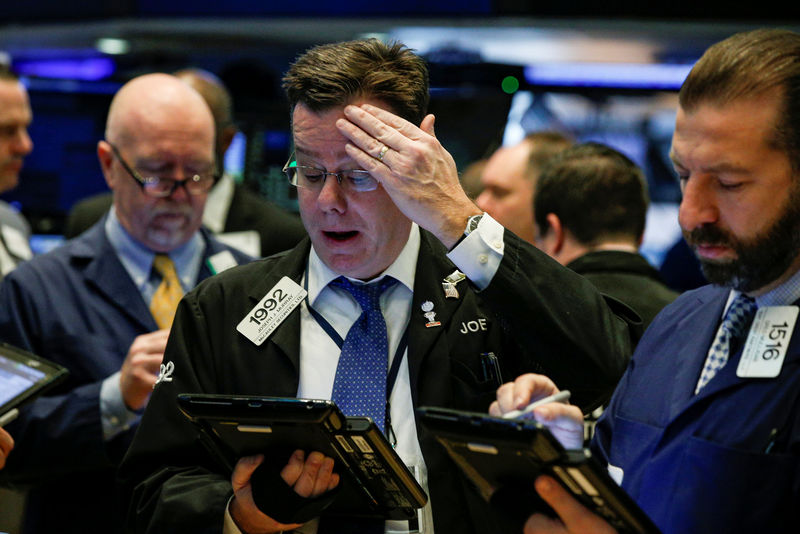Investing.com - Here are the top five things you need to know in financial markets on Friday, April 6:
1. Trade tariffs continue to keep markets on edge
Tariffs between the U.S. and China continued to keep markets on edge on Friday as a day earlier Trump ordered trade representative Robert Lighthizer to consider additional tariffs on $100 billion of Chinese imports, escalating the trade conflicts between the world’s two largest economies.
Trump’s decision came after Thursday’s market close and China’s state media was quick to respond on Friday, saying that Beijing will defend its interests "against new U.S. actions" in a similar fashion seen earlier in the week.
Despite the fact that this is the third round of threats from the U.S., starting dates for several of the tariffs announced by both sides have yet to be implemented and Trump's chief economic adviser Larry Kudlow said late Wednesday that proposed tariffs on China may not actually take effect, while insisting that it was not the President’s intention to start an all-out trade war.
The Chinese commerce ministry was reportedly scheduling to hold a press conference at 8:00AM ET (12:00GMT) which could provide further insight on China's next step in the dispute.
2. Stocks continue with jitters over trade tensions
Stock markets traded mostly lower on Friday after U.S. President Donald Trump's threat to impose an extra $100 billion in tariffs on China exacerbated fears of a more serious trade dispute.
In Asia, Japan’s Nikkei 225 closed with losses of 0.4% on Friday, while Shanghai’s stock market was closed for a holiday.
European shares moved lower on Friday after Trump’s warned of further tariffs on China, although losses were limited by gains among defensive stocks like utilities.
U.S. futures, coming off the prior session’s solid gains, pointed to sharper losses at the open on Friday. At 5:58AM ET (9:58GMT), the blue-chip Dow futures fell 181 points, or 0.72%, S&P 500 futures lost 17 points, or 0.65%, while the Nasdaq 100 futures traded down 45 points, or 0.68%.
3. Nonfarm payrolls on tap
Amid escalating trade-war fears, investors are likely look to nonfarm payrolls data due out at 8:30AM ET (12:30GMT) Friday for market direction.
Nonfarm payrolls are expected to show 193,000 jobs were created in March, while economists forecast the jobless rate to decline to 4.0%.
Given the solid state of the U.S. labor market, investors will likely focus their attention on average hourly earnings, with March’s reading expected to jump to a 0.3% gain from the prior month. That would translate to an increase in annual wage inflation to 2.7% from February’s reading of a 2.6% advance.
Signs of increasing wage growth in the report could underline the case for the Federal Reserve to raise interest rates at a faster pace.
Former Fed chair Janet Yellen said that she felt three to four rate hikes this year would be likely.
4. Fed chief Powell may quickly comment on jobs report
Current Fed chairman Jerome Powell will have the first opportunity to comment on the jobs report. He is scheduled to speak about the economic outlook at the Economic Club of Chicago on Friday at 1:30PM ET (17:30GMT).
The Fed hiked rates last month and stuck to its projection for two more rate hikes this year, implying a total of three increases in 2018.
Market participants are playing close attention to any shift in the Fed’s stance that might imply a larger number of increases.
Fed fund futures currently price in the possibility of four total hikes, a further three, this year at just over 30%, according to Investing.com’s Fed Rate Monitor Tool.
5. Oil heads lower amid trade tension
Oil prices moved lower on Friday, as geopolitical tensions continued between the U.S. and China, and investors looked ahead to latest gauge of U.S. shale production.
Not unlike stocks, traders have been cautious to take a bullish stance in the risk asset, while they struggle to weigh the balance between escalating U.S. shale output and the possibility of an extension in the deal from the Organization of the Petroleum Exporting Countries’ and Russia to curb production and end a global supply glut.
The weekly installment of drilling activity from Baker Hughes later on Friday, will provide investors with fresh insight into U.S. oil production and demand after data last week showed the number of U.S. oil rigs fell for the first time in three weeks.
U.S. crude oil futures fell 0.38% to $63.30 at 6:04AM ET (10:04GMT) on Friday, while Brent oil lost 0.35% to $68.09.
